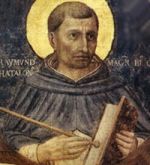The Church's Thanksgiving Day
We may describe All Saints' feast as the Church's Thanksgiving Day. For today we combine worship of God with family reunion: "Let us all rejoice in the Lord, and keep a feast in honor of all the Saints; the angels rejoice in this solemn occasion and join in praising the Son of God." The Introit carries the right note of happiness, which continues throughout the Mass.
THE MASS, HOLIDAYS, AND HALLOWMAS
The Mass has left its mark on our language in several named days that date back to Catholic feasts in Anglo Saxon times. These were the principal holidays in pre-Reformation England, when the only reason that could win workers a rest was the worship of God on holy days. Best known is Christmas, the Mass of the infant Christ. But there are others: Candlemas, the feast of Our Lady's Purification, when candles were blessed; March 25th was sometimes referred to as Marymass; Lammas, or Loaf Mass, was the harvest festival on August 1st; Michaelmas, the archangel's day, September 29th; Martinmas, November 11th, feast of St. Patrick's uncle; goose-summer, when geese were plentiful—it gives us the word gossamer; and to-day, Hallowmas.
Hallow meant "holy one," hence the name All Hallows for All Saints. Pope Gregory IV arranged this feast for the universal Church more than eleven hundred years ago. His intention was to comply with a general desire that none of God's great friends should be neglected.
The Church is a family, but Christians in different places had their special preferences. Rome venerated its Apostles, and all Christendom joined in that. But Milan had martyrs, too. Then there were the French with St. Denis, Martha, Mary, and Lazarus; the apostles of England, Scotland and Ireland; Wales also; and the men who had brought the faith to Germany and northern Europe. In Greece and Asia Minor was no end to the number of saints. No one could name them all, but one feast could include them all.
MARTYRS, SAINTS, AND THE BEATITUDES
In view of the blessings pronounced by Our Lord in the gospel of the Beatitudes, the high regard Christians had for their brethren in heaven is perfectly understandable. These were God's tested and proven friends: "in the sight of the unwise they seemed to die, but they are in peace" (Offertory). Triumphing over death was their first mark of holiness. Just as Christ died to give witness to his Father, His Apostles were allowed the privilege of martyrs as true witnesses unto death.
The early persecutions brought the blessing of martyrdom to a vast army of men and women. Their names were recorded in lists, or diptychs, and as far as possible the anniversaries of their entry into heaven was kept. On martyrs' days, bishops led their people to the tombs and offered Mass over the tombs of God's heroes; this is the origin of burying small relics of martyrs in the altar stone. And during the Mass bishops mentioned the names of their special martyrs.
The saints mentioned in the Canon of the Mass are the Apostles, Popes, St. Cyprian (who actually had a dispute with Pope St. Stephen), Lawrence the Deacon, and two doctors, Cosmas and Damian—all martyrs. After the Consecration, a second list mentions famous women on the martyr list at Rome: Lucy, Agnes, Cecilia, and St. Anastasia, remembered in the second Mass of Christmas day, even when this is sung solemnly—a special distinction.
Saints who are not martyrs do not appear in the Ordinary of the Mass. The Queen of Martyrs, our Lady, is naturally mentioned, and Apostle John also; he would rank with the Twelve in any case, even though he had not been twice subjected to persecution that should have brought death; and great St. John the Baptist.
Martyrs are those whom St. John saw "clothed in white robes, and with palms in their hands" (Epistle). "These are they who have come out of great tribulation, and have washed their robes and made them white in the blood of the Lamb" (Apoc. 7, 14). But there is a multitude of other saints in heaven.
ALL THE MEN AND WOMEN SAINTS OF GOD
St. Joseph, foster-father of Jesus, leads today's procession of men and women saints of God. None is left out. The friends Jesus had on earth: Lazarus, whom he raised from the dead and whose home he visited; Nicodemus and Joseph of Arimathea who buried him; Simon of Cyrene who helped with the cross; the faithful women, Martha and Mary; and Dismas, the repentant thief.
The public cult of even these New Testament saints became popular only when persecution had largely ceased. Then the Church was able peacefully to appreciate her blessings. She found them in the heroism not only of martyrs at death, but of those who excelled in the virtues of the gospel just read. God's single-minded enthusiasts, the poor in spirit, including popes and bishops, earn the title of blessed with those who suffered persecution. Merciful kings and judges trembled at their responsibility before God, and the humble earned blessing. Men and women who mourned in life rejoice and exult now in heaven. Our family there is glorious with endless praise and thanksgiving to God.
This item 6143 digitally provided courtesy of CatholicCulture.org






